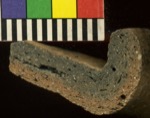Back to top: Late Chalcolithic Chaff Temper Ware (LCH)
General Description
Late Chalcolithic Chaff Tempered ware is distinguished by the thick carbon core and the abundance of chaff seen on the surface and in section. The vessels are handmade and range in color from gray-brown to bright orange.
Back to top: Late Chalcolithic Chaff Temper Ware (LCH)
Characteristics
| Basis for Definition | Terrace associated with revetment wall, J1 in front of terrace, J3 inside terrace. |
| Identifying Attributes | Thick carbon core, much chaff on both interior and exterior surfaces as well as in the section. |
| Clay Type | Coarse, not well levigated. |
| Temper | Much chaff up to a maximum, length of 5mm, often the chaff is not completely carbonized. Large mineral inclusions include a gray and a white type. The gray type can be as large as 3.5mm and have an angular shape (Sphercity factor 0.9 and Roundness factor 0.5). White inclusions may be calcite; they are smaller (less than 2mm) and rounder (Sphercity factor between 0.5 and 0.9 and Roundness factor 0.9). Some white mineral inclusions are larger (ca 4mm, Sphercity factor 0.7 and Roundness factor 0.7). A light gray mineral inclusion can be seen on interior, exterior and in the section; they are poorly distributed (have a size less than 5mm, Sphercity factor 0.9 and Roundness factor 0.7). |
| Firing | Low fire, most have a wide carbon core with only the thin surface of the exterior and interior a brownish-red. |
| Firing Cloud | None. |
| Color | Gray-brown to bright orange, a small number of sherds are buff. Evidence of use: many shapes have traces of secondary firing probably signifying that they were used in cooking. Some have a delimited carbon stain on the rim indicating use as a lamp. Many hammer rim bowls have traces of firing on the interior but not the exterior. These bowls have evidence of use ware on the inside edge of the rim, indicating a stirring activity. |
| Surface Treatment | Some forms have a thick slip. Hammer rim bowls and small jars have either a wet smooth exterior and interior or are left relatively coarse. Coarser shapes also have a slipped and wet smooth surface. A few examples are burnished with a type of space burnishing stroke but in non-parallel directions. One sherd may have a potter's mark (J1 f196). |
| Wall Thickness | Hammer rim bowls below the rim ca 1cm; flat bowl near the center 1 cm or thicker; small jars below the rim 1 cm. |
| Manufacturing Techniques | Handmade. |
| Shapes |
Hammer rim bowls. Flat bowls. Small jars. Some thicker body sherds may come from medium to large jars. |
| Comments |
A variation of this ware with few examples in the ceramic inventory excavated so far is thinner walled, much chaff temper, medium and fine calcite temper some with rehydration, higher fired even though this variation still has a carbon core. The surface can be left coarse or be covered with a red-brown slip and burnished. |
Back to top: Late Chalcolithic Chaff Temper Ware (LCH)
Sherd Illustrations
 |
 |
 |
 |
Back to top: Late Chalcolithic Chaff Temper Ware (LCH)